外研版(2019)选择性必修第一册Unit 5 Into the wild Starting out and Using language课件(20张ppt)
文档属性
| 名称 | 外研版(2019)选择性必修第一册Unit 5 Into the wild Starting out and Using language课件(20张ppt) |  | |
| 格式 | zip | ||
| 文件大小 | 30.5MB | ||
| 资源类型 | 教案 | ||
| 版本资源 | 外研版(2019) | ||
| 科目 | 英语 | ||
| 更新时间 | 2021-11-03 22:01:34 | ||
图片预览

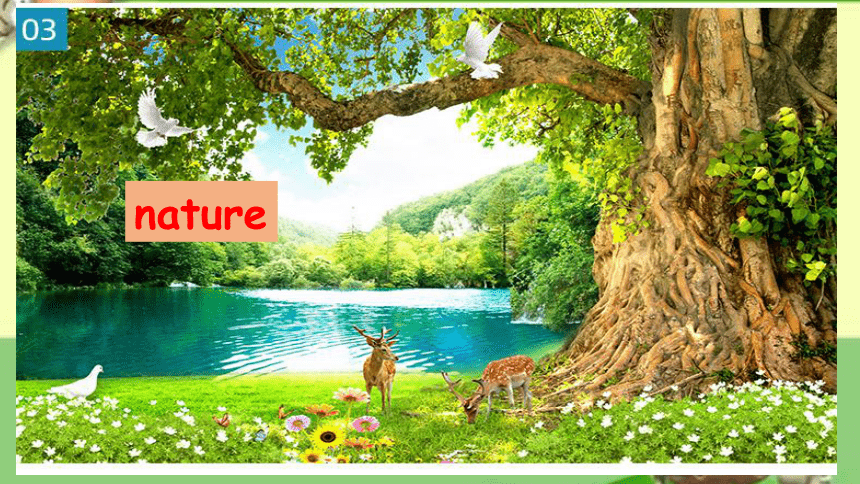
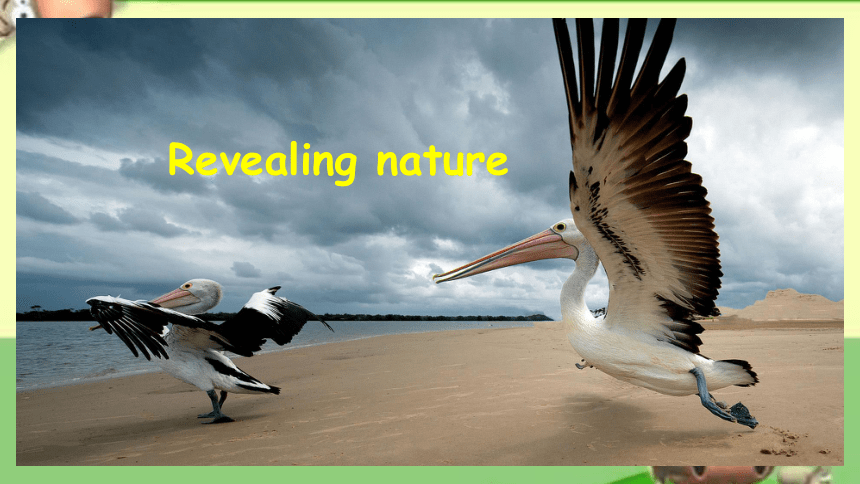
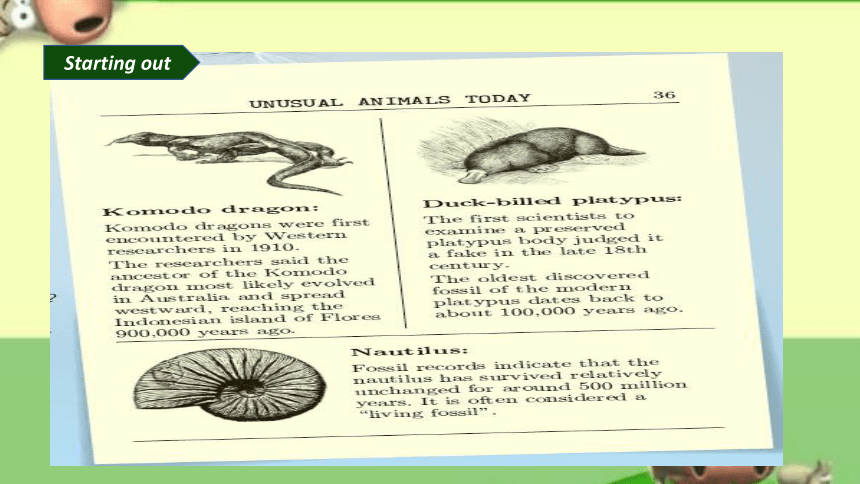
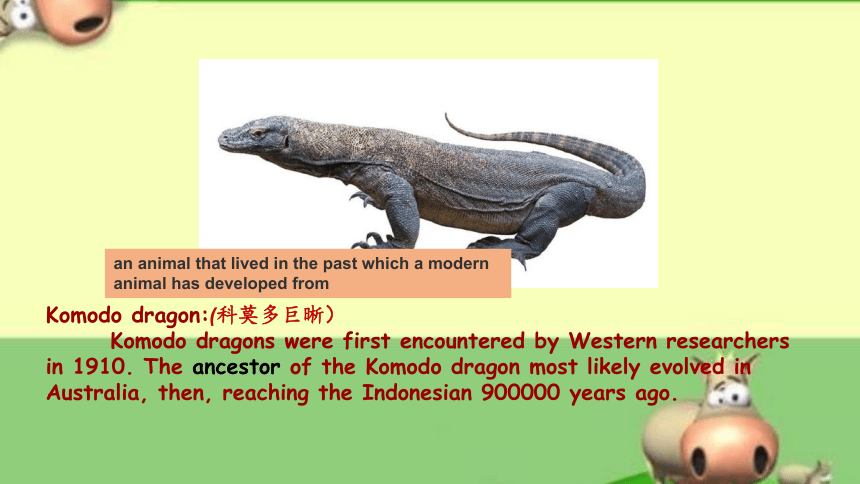
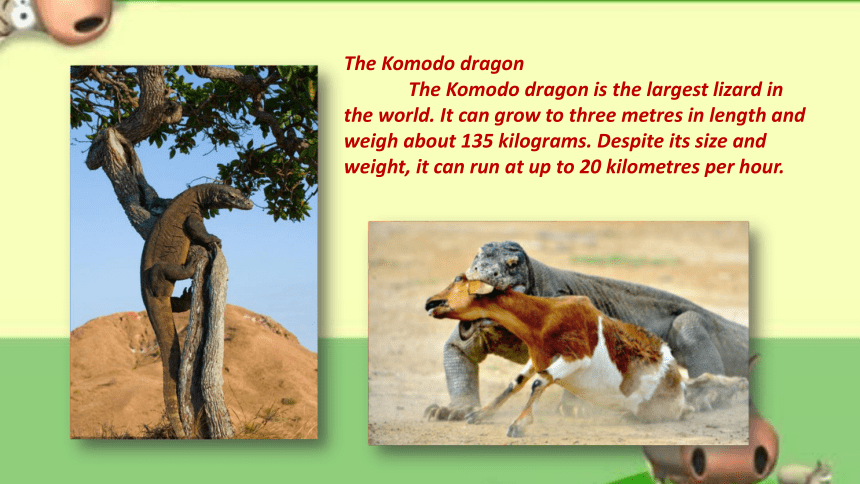
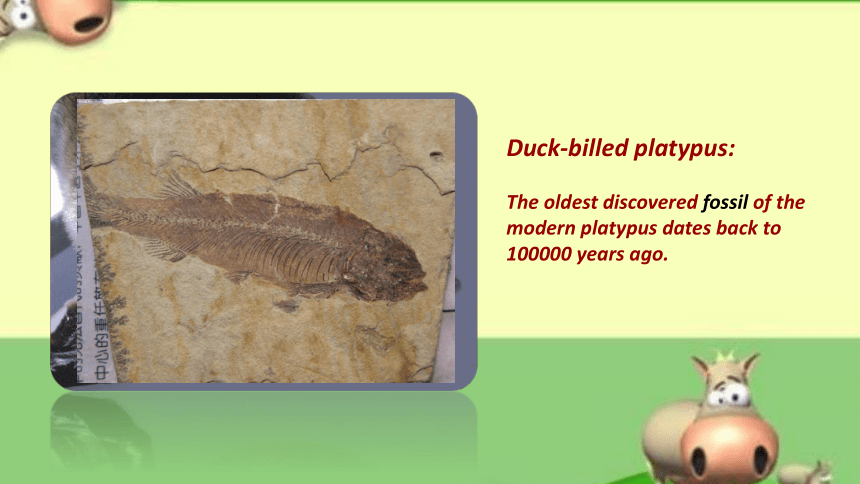
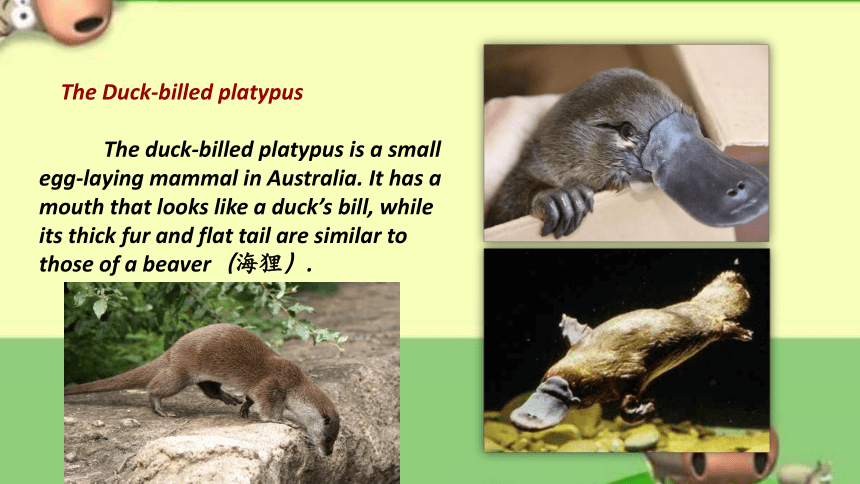
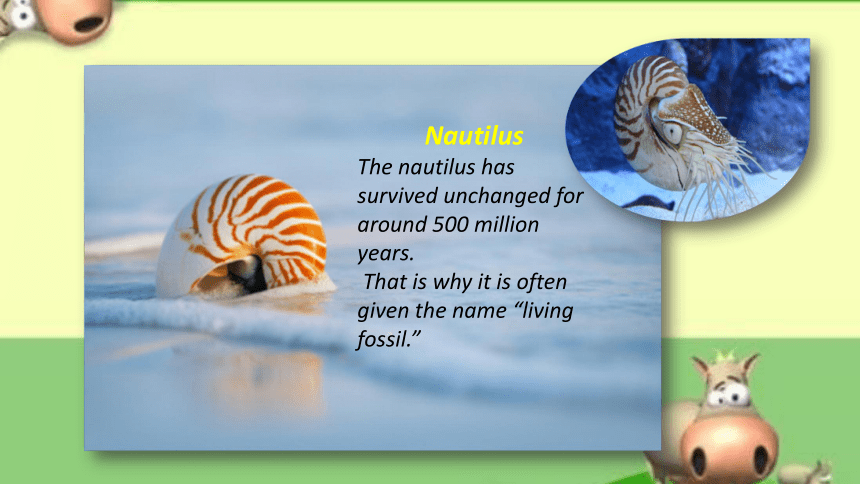
文档简介
(共20张PPT)
nature
Revealing nature
Starting out
Komodo dragon:(科莫多巨晰)
Komodo dragons were first encountered by Western researchers in 1910. The ancestor of the Komodo dragon most likely evolved in Australia, then, reaching the Indonesian 900000 years ago.
an animal that lived in the past which a modern animal has developed from
The Komodo dragon
The Komodo dragon is the largest lizard in the world. It can grow to three metres in length and weigh about 135 kilograms. Despite its size and weight, it can run at up to 20 kilometres per hour.
Duck-billed platypus:
The oldest discovered fossil of the modern platypus dates back to 100000 years ago.
The Duck-billed platypus
The duck-billed platypus is a small egg-laying mammal in Australia. It has a mouth that looks like a duck’s bill, while its thick fur and flat tail are similar to those of a beaver(海狸).
Nautilus
The nautilus has survived unchanged for around 500 million years.
That is why it is often given the name “living fossil.”
How can seeds travel
How can this benefit plants
Seeds usually are carried by the wind, water, and animals.
Plants can have a better chance at life.
Watch the video and answer the questions.
2. Do you know some other examples about seeds travelling
Dandelion seeds have little parachutes to catch the wind and go further;
Humans can spread seeds if seeds get stuck to their clothing or shoes.
Biodiversity
Listen to the podcast and choose the statements that are made.
1 Biodiversity is important.
2 Bacteria are always harmful to humans.
3 Some species of bacteria are used in food production.
4 Many species of bacteria recycle dead organic matter.
5 Our immune systems are able to fight off all germs.
√
√
Biodiversity
Listen again and complete the fact sheet.
Cells
Every living thing is 1________________________. They are like 2___________________________________.
In the human body there are about 3___________________ human cells and around 4___________________ bacteria cells.
Bacteria
Most bacteria in the human body can 5___________________.
In the food production process, bacteria can 6___________________ dead organic matter.
made up of cells
bricks that are used to build houses
thirty trillion
thirty-nine trillion
help with digestion
break down
There are 3 benefits of bacteria mentioned in this podcast, what are they
Complete the boxes with the expressions from the podcast.
Do you know about...
By the way, ...
Actually,...
Have you heard of ...
In fact, ...
Speaking of which, ...
Checking background knowledge
Adding information
Do you know about...
Have you heard of...
By the way, ...
Actually, ...
In fact, ...
Speaking of which, ...
Read the passage and answer the questions.
1 What species are mentioned and what is special about them
Earth is home to millions of different species. Some can be very small, like bacteria and viruses, which are so small that we cannot see them with only our eyes. By contrast, the largest animal species so far found on our planet is the blue whale, which can grow up to almost 30 metres in length and weigh over 130,000 kilos. The toughest species is probably the water bear. This tiny organism can survive temperatures from 150℃ to a below freezing -272℃ . To best survive in their environment, each species has developed its own unique physical characteristics.
Each year, scientists identify around 15, 000 new species. However, diversity on our planet is such, that there are still millions of species on Earth remaining to be discovered.
Two species are mentioned: the blue whale and the water bear. The blue whale is the largest animal species on Earth, which can grow up to almost 30 metres in length and weigh over 130, 000 kilos. The water bear is probably the toughest species, which can survive temperatures from 150℃ to a below freezing -272℃.
Read the passage and answer the questions.
2 What other unusual life forms do you know of
Earth is home to millions of different species. Some can be very small, like bacteria and viruses, which are so small that we cannot see them with only our eyes. By contrast, the largest animal species so far found on our planet is the blue whale, which can grow up to almost 30 metres in length and weigh over 130,000 kilos. The toughest species is probably the water bear. This tiny organism can survive temperatures from 150℃ to a below freezing -272℃ . To best survive in their environment, each species has developed its own unique physical characteristics.
Each year, scientists identify around 15, 000 new species. However, diversity on our planet is such, that there are still millions of species on Earth remaining to be discovered.
nature
Revealing nature
Starting out
Komodo dragon:(科莫多巨晰)
Komodo dragons were first encountered by Western researchers in 1910. The ancestor of the Komodo dragon most likely evolved in Australia, then, reaching the Indonesian 900000 years ago.
an animal that lived in the past which a modern animal has developed from
The Komodo dragon
The Komodo dragon is the largest lizard in the world. It can grow to three metres in length and weigh about 135 kilograms. Despite its size and weight, it can run at up to 20 kilometres per hour.
Duck-billed platypus:
The oldest discovered fossil of the modern platypus dates back to 100000 years ago.
The Duck-billed platypus
The duck-billed platypus is a small egg-laying mammal in Australia. It has a mouth that looks like a duck’s bill, while its thick fur and flat tail are similar to those of a beaver(海狸).
Nautilus
The nautilus has survived unchanged for around 500 million years.
That is why it is often given the name “living fossil.”
How can seeds travel
How can this benefit plants
Seeds usually are carried by the wind, water, and animals.
Plants can have a better chance at life.
Watch the video and answer the questions.
2. Do you know some other examples about seeds travelling
Dandelion seeds have little parachutes to catch the wind and go further;
Humans can spread seeds if seeds get stuck to their clothing or shoes.
Biodiversity
Listen to the podcast and choose the statements that are made.
1 Biodiversity is important.
2 Bacteria are always harmful to humans.
3 Some species of bacteria are used in food production.
4 Many species of bacteria recycle dead organic matter.
5 Our immune systems are able to fight off all germs.
√
√
Biodiversity
Listen again and complete the fact sheet.
Cells
Every living thing is 1________________________. They are like 2___________________________________.
In the human body there are about 3___________________ human cells and around 4___________________ bacteria cells.
Bacteria
Most bacteria in the human body can 5___________________.
In the food production process, bacteria can 6___________________ dead organic matter.
made up of cells
bricks that are used to build houses
thirty trillion
thirty-nine trillion
help with digestion
break down
There are 3 benefits of bacteria mentioned in this podcast, what are they
Complete the boxes with the expressions from the podcast.
Do you know about...
By the way, ...
Actually,...
Have you heard of ...
In fact, ...
Speaking of which, ...
Checking background knowledge
Adding information
Do you know about...
Have you heard of...
By the way, ...
Actually, ...
In fact, ...
Speaking of which, ...
Read the passage and answer the questions.
1 What species are mentioned and what is special about them
Earth is home to millions of different species. Some can be very small, like bacteria and viruses, which are so small that we cannot see them with only our eyes. By contrast, the largest animal species so far found on our planet is the blue whale, which can grow up to almost 30 metres in length and weigh over 130,000 kilos. The toughest species is probably the water bear. This tiny organism can survive temperatures from 150℃ to a below freezing -272℃ . To best survive in their environment, each species has developed its own unique physical characteristics.
Each year, scientists identify around 15, 000 new species. However, diversity on our planet is such, that there are still millions of species on Earth remaining to be discovered.
Two species are mentioned: the blue whale and the water bear. The blue whale is the largest animal species on Earth, which can grow up to almost 30 metres in length and weigh over 130, 000 kilos. The water bear is probably the toughest species, which can survive temperatures from 150℃ to a below freezing -272℃.
Read the passage and answer the questions.
2 What other unusual life forms do you know of
Earth is home to millions of different species. Some can be very small, like bacteria and viruses, which are so small that we cannot see them with only our eyes. By contrast, the largest animal species so far found on our planet is the blue whale, which can grow up to almost 30 metres in length and weigh over 130,000 kilos. The toughest species is probably the water bear. This tiny organism can survive temperatures from 150℃ to a below freezing -272℃ . To best survive in their environment, each species has developed its own unique physical characteristics.
Each year, scientists identify around 15, 000 new species. However, diversity on our planet is such, that there are still millions of species on Earth remaining to be discovered.
